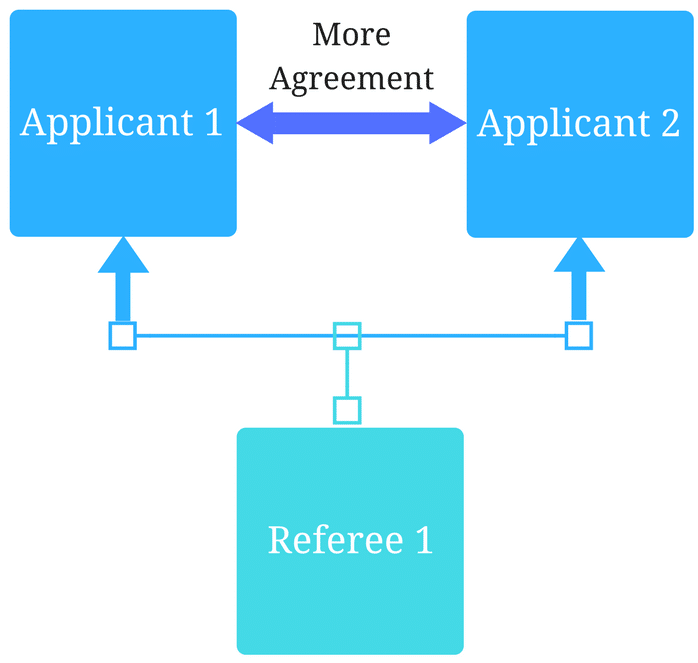Why programs need to reconsider “fit” in admissions

May 11, 2022
What is fit?
Fit can be a hard term to define, but many people in higher education admissions and workplace recruitment tend to define it as ‘culture fit.’ This refers to the applicant’s “attitude, motivation and values, and whether [they are] aligned with the culture.” But even this definition is vague if programs aren’t rigorously defining and weighing those cultural components and values. That’s why “fit” or “culture fit” ends up being misunderstood and misused in the decision-making process. For example, someone could make a decision on an applicant based on the thought, “this person is/isn’t like me,” as opposed to how the applicant’s personal values align with the program’s.
This results in missed opportunities, especially since a psychological study by Kristof-Brown showed that fit, when assessed in a robust and standardized way, plays an important role in performance, commitment, and identity within the workplace. This can also apply to universities. Programs can benefit from applicants having:
- Greater program satisfaction
- A higher likelihood of success
- A higher level of commitment
- Better performance
- A connection with their program
Don’t trust your gut when it comes to fit
When considering “fit” during the admissions process, your gut is often thought of as a reliable source. However, your gut may be wrong.
Why?
Your gut may not be neutral. As mentioned above, it may guide you to applicants who are like you with respect to personal values, rather than those who are most aligned to the program values. Program values and personal values are the same in regard to defining an identity. However, personal values are “broad desirable goals that motivate people’s action and serve as guiding principles in their lives” while program values are chosen and pre-set by various program stakeholders (e.g. faculty, administrators, and current learners). The two aren’t always the same.
Focusing on alignment with program values can help with this problem, but to do this, admissions officers require a strong mission statement, defined program values, and established decision processes.
Are admissions fair?
Fairness means a “broad access to human and intellectual resources that supports institutional goals.” Although test-based admissions may appear fair, the cost of admission to elite universities can be prohibitive for some students, who may need to pay for expensive prep courses to get the score required for admission. Therefore, only using scores from tests such as MCAT ignores the educational opportunities available to some individuals.
For example, Stanford University Professor Sean Reardon found a gap in academic performance in relation to race and income. He stated, “on average white students score one and [a] half or more grade levels higher than black and Hispanic students enrolled in socioeconomically similar school districts.” This can’t be fair. How can we improve the admissions process?
There are some tools admissions teams can use to support more holistic applicant review. Examples include Situational Judgment Tests (SJTs), which probe an applicant’s critical reasoning and behavioral tendencies when presented with social and workplace-based dilemmas they would likely encounter in the profession. Other tools include structured interviews such as MMIs and one-way video interviews. Incorporating these tools in your toolbox allows you to consider more of an applicant’s background including personal and professional characteristics. They still take “fit” into consideration by looking at competencies and motivation for the profession that programs consider to be important, but in a more thoughtful and structured way as compared to other methods like personal statements, unstructured interviews, and reference letters that may lead to gut decisions.
Programs and applicants should help each other
The tools mentioned above help support more holistic applicant reviews, but programs and applicants can gain even more with a focused assessment of value alignment, especially as program mission statements gain importance in admissions.
To do this, programs need to work with their stakeholders to define their program’s values and consider how applicants perceive “fit” and the various factors that go into their decisions when ranking programs. For example, The 2021 National Resident Matching Program (NRMP) report found one of the top considerations for applicants was “goodness of fit.”
Clearly defined values can help applicants when evaluating programs. This enables programs to attract a stronger pool of applicants that align with their mission statement as well as values. Those that ‘fit.’
How “fit” can be reconsidered
It’s clear that admissions decisions can be strengthened by looking at how applicants’ values align with the program’s and not just the values of the individual decision-maker. This program-level approach to value alignment is a better way to consider “fit” in the decision-making process because it has defined program categories and values created by multiple stakeholders.
Duet is our standardized value-alignment assessment that helps programs consider “fit” in a more fair way during the admissions process. Various stakeholders within the program complete the assessment, creating a single Program Profile based on three categories of the program’s values and priorities (of which culture is one of the three categories). Applicants then complete the same assessment to show what values they prefer in a program. Lastly, your program will receive automatic scores showing how well the applicants align with your Program Profile.
Ready to assess “fit” more objectively?
Related Articles

How interviews could be misleading your admissions...
Most schools consider the interview an important portion of their admissions process, hence a considerable…
Reference letters in academic admissions: useful o...
Because of the lack of innovation, there are often few opportunities to examine current legacy…
